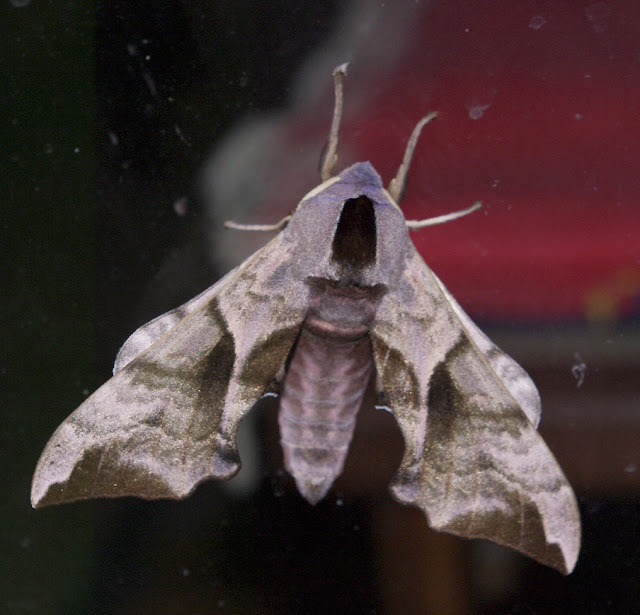The most exciting was a Giant Peacock Moth [Saturnia pyri] Grand-Paon-de-nuit which visited on the 11th... absolutely huge, it was at least 15cm [3"] across....
 |
| Now that's more my size of prey! |
 |
| They don't normally have this sparkle, do they? |
 |
| Hey, Mum... have you seen this! The cat's heads and the Fox Moth give scale to this magnificent moth. |
...it had the full attention of the cats... but was very difficult to photograph... it wouldn't stop flying around.
Most of the other moths have been far more sedentary... settling for long periods.
But it did eventually settle for a moment.... and I got a lovely shot of it on our step.
 |
| The step is 27cms left to right. |
I found the remains of another that had probably fed a bat, by the Mairie in Grand Pressigny - a full hindwing and a few shreds of the others. [27/05/12 - Also a front wing by our back door... the front rib of which is constructional strength steel.... by the feel of it. The colours of the two wings are much faded when compared with these pix, too.]
A second member of the Saturniidae that has been around is the Fox Moth [Macrothylacia rubi] Bombyx de la ronce... we get loads of these. They really are daft creatures... laying eggs on our doors like the Emperor Moth on our window [blogged about here and one that Susan wrote about here]... the titchy caterpillars have to cross three metres of bare calcaire! An adult female can be seen in [above pic] which then went on to start laying much to the amazement of our RonRon as she had noticed a male that was still trying to mate... so she tried to separate them...
 |
| What's going on here? |
 |
| That can't be right! [the female is the lower one and the eggs are the pale dots on the door frame beneath her.] |
 |
| Better separate them then...? |
Another visitor was an Eyed Hawkmoth [Smerinthus ocellata] Sphinx Demi-Paon...
...we usually have our attention drawn to where the 'bonking' is coming from by the cats!!
This was no exception... RonRon the 'scientist' made a mad dash across the tops of the work surfaces to the kitchen window... before being told off... but by the time I'd managed to get the camera and get outside, it had moved to the lounge window... lower and more convenient for photography.
You can see here the eye is just visible...
 |
| Eyed Hawkmoth female. |
 |
| This and the Poplar Hawkmoth have a strange wing profile. |
I risked holding the wings open to show the eyes more clearly....
 |
| Still not perfect, but I didn't want to damage her! |
Surprisingly, she didn't object!!
As mentioned before, we get lots of 'night visitors' and here are a few more in no particular order!
 |
| Lunar Thorn or Purple Thorn moth [Selinia spp] |
 | |
| The same Lunar Thorn or Purple Thorn moth [Selinia spp], a couple of ichneumon flies [Ophion luteus & Lissonota setosa] and a micromoth. |
 |
| Ichneumon fly [Ophion luteus /Ophion sp.] |
 |
| An Art Deco micromoth and some more night visitors including an ichneumon. |
 |
| Moth in a smoking jacket! Peach Blossom Moth [Thyatira batis] La Batis |
























